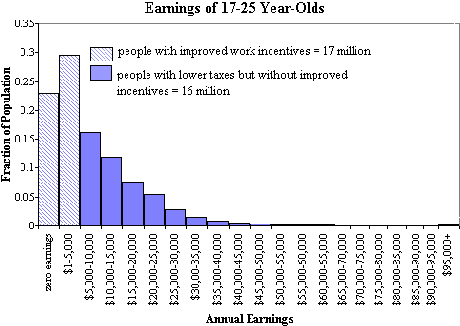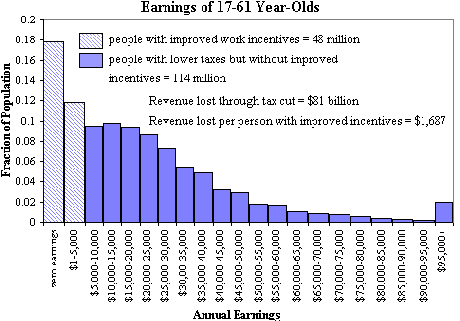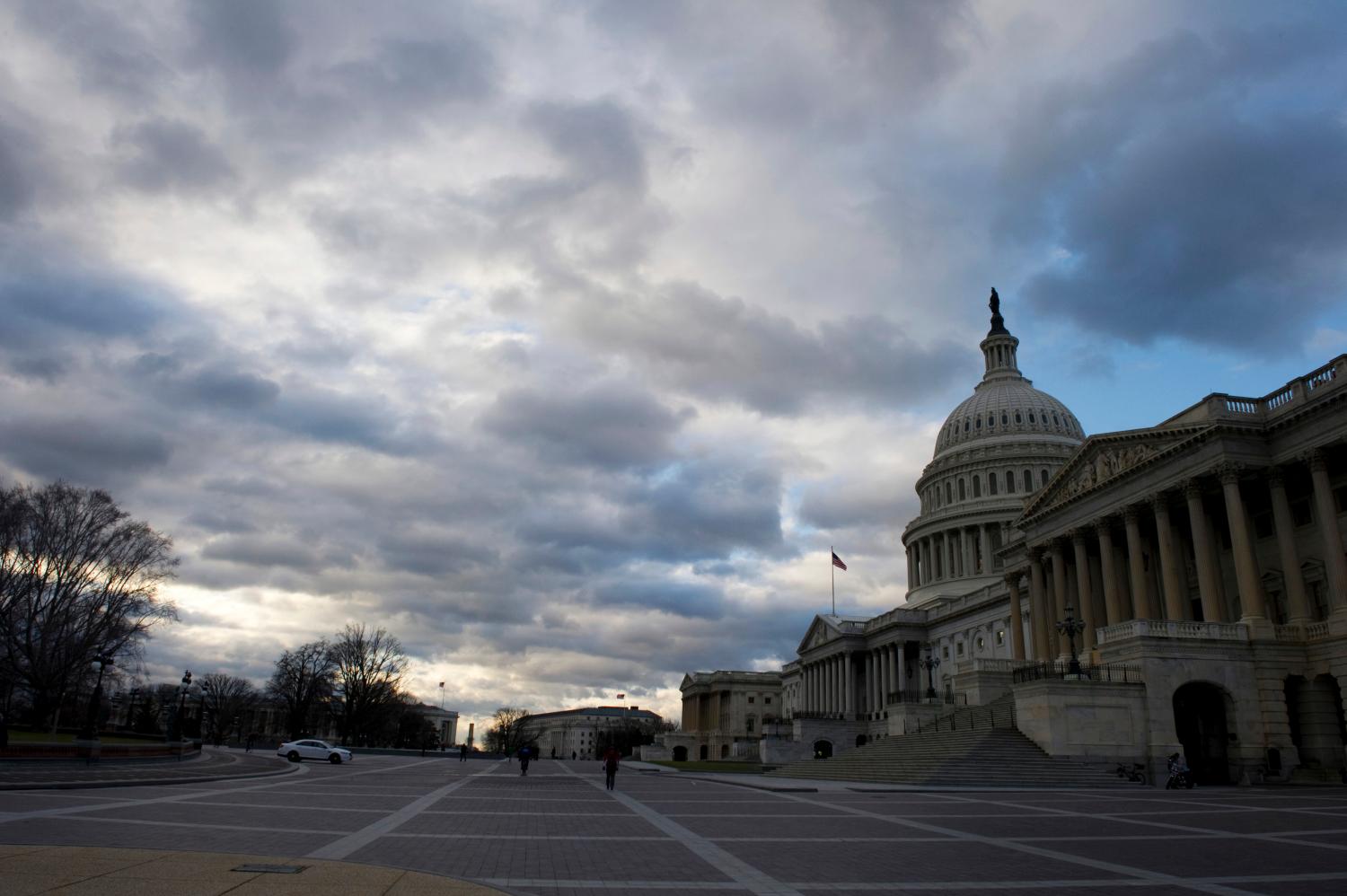The $100 billion in surplus accumulated by the Social Security Trust Fund each year has led some to call for tax cuts. This brief argues that if taxes are to be cut, priority should be given to exempting the first $5,000 of earnings from Social Security taxes for youth. Such an exemption would reduce the regressivity of the Social Security tax system and improve work incentives for those with low earnings. Targeting the tax exemption to youth would more than double the improvement in work incentives for a given loss in tax revenue. This is because young people are more likely than prime-age workers to earn under $5,000 annually, and are more responsive to improved work incentives. If policymakers decide to save the surplus for future generations, they could improve work incentives and equity by incorporating a youth tax exemption within a revenue-neutral Social Security tax reform.
POLICY BRIEF #40
Currently, employees and employers each pay 6.2% in Old-Age, Survivors, and Disability Insurance (OASDI) taxes up to an earnings threshold of $68,400, and no taxes on earnings above this threshold. Many economists believe that employers pass on almost all of these taxes to employees in the form of lower wages, and therefore that OASDI taxes should be thought of as a 12.4% tax on the first $68,400 of workers’ earnings. Since earnings above the $68,400 threshold are not subject to OASDI taxes, high earners pay a lower proportion of their earnings in OASDI taxes. (An additional 2.9% of earnings is collected to pay for Medicare, with no earnings threshold.)
OASDI taxes not only transfer resources from workers to the retired, but also reduce the size of the economic pie by reducing work incentives. Workers will be less likely to work additional hours if the government directly and indirectly takes 12.4% of every dollar they earn.
Ideally, any tax reform would reduce the tax burden borne by those with low lifetime earnings and also reduce the loss in economic output due to work disincentives. These equity and efficiency objectives are often thought to conflict. This brief argues that exempting the first few thousand dollars of earnings from Social Security taxes for young workers can achieve both these objectives.
To see why there may be a conflict between improving incentives and reducing the tax burden on the poor, note that people’s work incentives depend on their tax bracket, or what economists call their marginal tax rate. Reducing the tax bracket over a particular earnings range improves work incentives only for people within that earnings range. Suppose that the first $5,000 of earnings were exempt from OASDI taxes, just as the first few thousand dollars of income are currently exempt from income tax. In this case, people earning less than $5,000 would be able to keep each extra dollar that they earned. These low earners would therefore have greater incentive to take jobs, or, if they already had part-time jobs, to work for more hours a week or more months during the year.
On the other hand, workers earning more than $5,000 would stay in the same tax bracket. Since the government would still take 12.4 cents in Social Security contributions out of every additional dollar earned beyond $5,000, the tax exemption would not increase their incentive to work additional hours. In fact, since the tax bill for people earning more than $5,000 would fall by 12.4% of $5,000, or $620, they might actually reduce their work effort, knowing they could maintain the same standard of living with fewer hours of work.
The beneficial effects on work incentives of lowering marginal tax rates have to be weighed against the need for tax revenue. A first step in measuring the cost-effectiveness of a tax cut in improving work incentives is to calculate the revenue forgone for every worker with improved incentives. Eliminating OASDI taxes on the first $5,000 of earnings would reduce annual Social Security revenue by $81 billion. (All estimates are based on the 1997 Current Population Survey, the most recent available, which surveys 1996 earnings.) However, only 48 million of the 162 million U.S. adults between the ages of 17 and 61 earn $5,000 a year or less and hence would face stronger work incentives. (See figure 1.)

Thus $1,687 in tax revenue would be lost for every person who would face improved work incentives (neglecting, for the moment, the impact of increased labor supply on tax revenue.)
Reductions in tax rates at low earnings levels incur a particularly high cost in lost tax revenue. This is because there are many workers with higher earnings who would pay a lower total tax bill, even though their work incentives have not improved. Thus the efficiency objective of improving work incentives without losing much tax revenue may conflict with the distributional objective of reducing taxes at the low end of the earnings distribution.
Tax cuts for youth could help resolve this conflict and improve work incentives while minimizing forgone tax revenue. Exempting the first $5,000 of earnings from OASDI taxes for workers aged 25 and under would reduce tax revenue by only $12.4 billion. Of the 33 million people between the ages of 17 and 25, a total of 17 million, or 53%, earn $5,000 a year or less, and hence would have stronger work incentives (See figure 2).
 This implies that a tax exemption targeted to youth would cost only $730 in forgone revenue for each worker with improved work incentives. Recall that an untargeted $5,000 exemption would cost $1,687 in forgone revenue for every person for whom work incentives were improved. Targeting tax cuts to younger workers thus reduces the revenue lost for every person with improved incentives by 57%. To put it slightly differently, targeting the tax exemption to youth more than doubles the number of people whose incentives will be improved for a given reduction in tax revenue.
This implies that a tax exemption targeted to youth would cost only $730 in forgone revenue for each worker with improved work incentives. Recall that an untargeted $5,000 exemption would cost $1,687 in forgone revenue for every person for whom work incentives were improved. Targeting tax cuts to younger workers thus reduces the revenue lost for every person with improved incentives by 57%. To put it slightly differently, targeting the tax exemption to youth more than doubles the number of people whose incentives will be improved for a given reduction in tax revenue.
Differential Sensitivity of Labor Supply to Taxes
The case for tax reductions for youth is even stronger than the calculations above suggest, since the amount by which output increases in response to tax cuts depends not only on the number of workers with stronger work incentives, but also on how responsive those workers are to the improved incentives. Economists disagree about how responsive workers are to taxes, but most agree that young people are likely to be more responsive to taxes than prime-age workers. Evidence suggests that many prime-age workers would continue to work 40 hours a week even if their wages or tax rates changed. In contrast, many more young people are on the margin of getting a job, or are deciding how many hours to work part-time. Clark and Summers (1981) have found that when economic conditions improve enough to cause a 1% increase in the proportion of prime-age men who work, the proportion of 16- to 19-year-olds employed increases approximately 4%. While not definitive, this evidence suggests that teenage employment may be much more responsive to economic conditions than prime-age employment.
Another reason OASDI taxes are particularly likely to discourage young people from work is that Social Security benefits are based on the 35 years of highest earnings. Unlike prime-age workers, most people under 25 are unlikely to be in their top 35 years of earnings; hence working more hours will increase their taxes without providing an offsetting increase in future retirement benefits.
Reducing the Tax Burden for Those with Low Lifetime Income
A $5,000 tax exemption for youth would reduce the share of the tax burden borne by people with low lifetime income. As noted earlier, if the exemption applied to all age groups, all people who earn more than $5,000 would have their taxes reduced by $620, and a substantial fraction of the tax reduction would go to people with high incomes. By contrast, a $5,000 exemption targeted to people 25 and under would reduce lifetime taxes for young people with full-time jobs and those working their way through school. It would not reduce lifetime taxes for people who stay in school until age 25 and whose parents fully finance their education. Security guards, sales clerks, and students working part-time would pay less in taxes. In contrast, future lawyers, doctors, and MBAs would not get a tax break, unless they were working to put themselves through school.
In the long run, exempting the first $5,000 of earnings from Social Security taxes for youth would not redistribute income between generations. Everybody is 22 once, and each generation would benefit from the exemption when it was young. However, those who were older than 25 when the exemption was introduced would never have an opportunity to take the exemption. This small benefit for youth may be warranted, given that young people are facing the unprecedented cost of supporting the baby boom generation when it retires.
Smoothing Consumption Over the Life Cycle
Ever since Joseph advised the Pharaoh to store grain to prepare for the seven lean years, sound financial planning has involved saving during good times to prepare for bad times. One purpose of Social Security is to transfer resources from prime-earning years to low-income retirement years. However, this logic does not justify transferring resources from youth to retirement. Many people have less income when they are just starting their careers than when they retire. According to the 1996 Current Population Survey, average income was $9,150 among 15-24 year-olds, whereas it was $18,314 among people 65 and older. Retirement needs should be financed by workers in their prime-earning years, rather than by young people who are often even poorer than retirees.
Of course, some young people have adequate income and anticipate that in their prime-earning years they will have greater needs, such as providing for children. These people can always transfer resources to their prime-earning years through private savings. At best, forcing young people to transfer resources to retirement through taxes is unnecessary. At worst, these taxes make it more difficult for them to finance high-return educational investments that could contribute much more to their long-run financial security.
Reducing Involuntary Unemployment and Crime
So far, I have lumped together the employer and employee portions of Social Security taxes, under the assumption that employers simply pass taxes on to employees in the form of lower wages. However, employers will not hire potential employees whose estimated productivity is less than the minimum wage plus the payroll tax. Exempting the first $5,000 of earnings from employer Social Security contributions would give employers an incentive to create jobs for people they would otherwise not be willing to hire. Tax exemptions for youth would be particularly cost-effective in reducing unemployment, which currently stands at 16% among those 16 to 19 years of age, in contrast to 4.6% among the population as a whole.
Tax exemptions might also make work more attractive relative to crime. Targeting youth may be particularly important for reducing crime, since a disproportionate number of youth are involved in crime. The arrest rate for property crimes among those aged 15 to 19 is 20 times that among those 50 to 54 (Herrnstein and Wilson, 1985). People under 21 constitute almost 60% of those arrested for the property crimes of larceny, burglary, and auto theft; and 37% of those arrested for the violent crimes of homicide, rape, robbery, and aggravated assault.
Maintaining Revenue Neutrality
If policymakers wanted to maintain revenue neutrality, the revenue that would be lost through a tax exemption could be recouped in several ways. The exemption would reduce revenue by $12.4 billion in the absence of a labor supply response, and by approximately $11.8 billion if one takes into account the labor supply response. If policymakers’ principal goal were to raise efficiency, they could recoup this revenue by raising the OASDI tax rate on the first $5,000 of earnings for the rest of the population. Under conservative assumptions about people’s responsiveness to work incentives, the necessary increase in the tax rate on the first $5,000 of earnings would be 2.36%, which implies that nobody would pay more than $118 in additional taxes. The improved work incentives created by this revenue-neutral restructuring of taxes would increase national output by $3.1 billion, a relatively large amount in response to a restructuring of only $12.4 billion in taxes. Note that such a policy would not only increase output but would also reduce the share of taxes borne by people with low lifetime earnings.
If policymakers wanted to further reduce the tax burden on those with low earnings and were willing to accept some trade-off in aggregate output, two alternative ways to maintain revenue neutrality would be to increase the OASDI tax rate by 0.42%, or to raise the threshold above which people pay no OASDI taxes by approximately $19,900.
The tax increases required to maintain revenue neutrality would be politically difficult. Needless to say, Social Security reform will entail many other politically difficult decisions, and it may be easiest to restructure Social Security taxes in the context of a broader reform.
Education
The impact this proposal would have on young people’s education is unclear. On the one hand, the tax exemption would make it easier for youth to earn enough part-time to work their way through college. On the other hand, the tax exemption might tempt some to work full-time instead of combining school with part-time work. This latter possibility, however, is unlikely, as students would earn approximately $5,000 if they worked at the minimum hourly wage of $5.15 full-time during the 3 summer months and 15 hours per week during the school year, while taking 9 weeks off work for school breaks and finals. Since any earnings from additional hours of work would be taxed at the full rate, the tax exemption would not tempt students to quit school in order to work full-time.
In addition, even with the tax exemptions, the government would still provide much more assistance to young people who pursue education than to those who work. Education subsidies currently total more than $4,900 per student per year. In contrast, the tax exemption would provide a maximum of $620 per year.
Finally, if the disincentive to education was thought to be a serious problem, the base tax rate could be raised enough to pay for both the tax exemption and increased support to education. A revenue-neutral combination of restructured taxes and increased support for education could preserve the current trade-off between education and work, while still reducing the overall disincentive effect of taxes by almost 30%.
Precedents
There are already a number of government programs aimed at particular age groups. People over 65 can take a special income tax deduction. Eligibility for the Earned Income Tax Credit among people without children is restricted to those 25 years and older. From 1979 to 1994, the Targeted Jobs Tax Credit (TJTC) offered tax credits to employers hiring qualified economically disadvantaged youth (as well as a few other targeted groups). Originally, the program applied to disadvantaged youths between the ages of 18 and 24, but in 1989 it was restricted to those between 18 and 22. Using this change in eligibility, Katz (1996) estimates that the TJTC increased youth employment by 3.4 percentage points, or 7.7%. Since the TJTC reduced wage costs by approximately 15%, it seems reasonable to assume that exempting the first $5,000 of earnings from the 12.4% OASDI tax could have almost as large an effect on youth employment.
Programs similar to those proposed here are already in place in some European countries. France recently reduced payroll taxes for employers who hire some categories of eligible youth, and in Switzerland, contributions to some retirement funds differ by age.
In summary, a $5,000 OASDI tax exemption for youth would improve work incentives at minimal cost in lost tax revenue, and would reduce the share of the tax burden borne by those with low lifetime income. It should be a priority in any Social Security reform.
The Brookings Institution is committed to quality, independence, and impact.
We are supported by a diverse array of funders. In line with our values and policies, each Brookings publication represents the sole views of its author(s).




